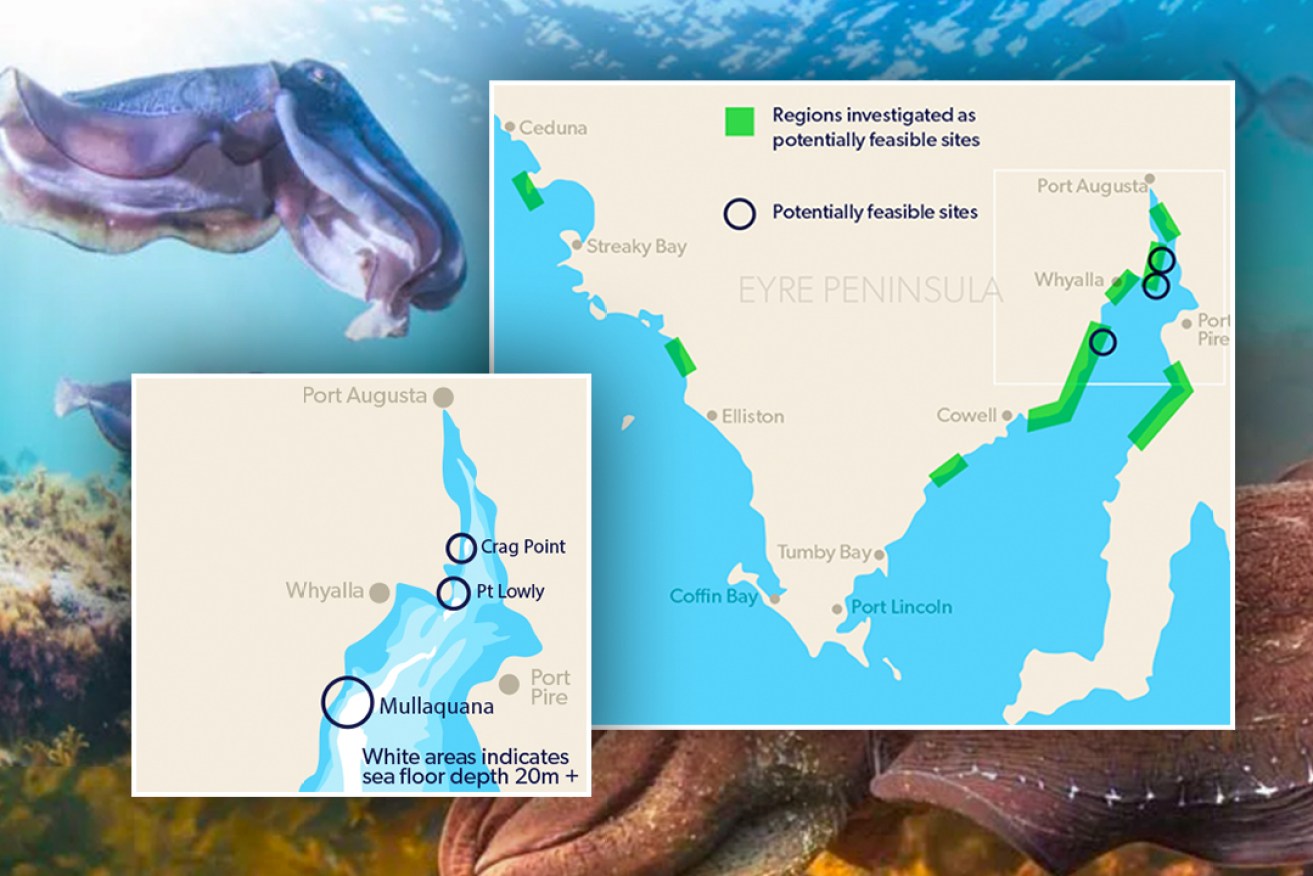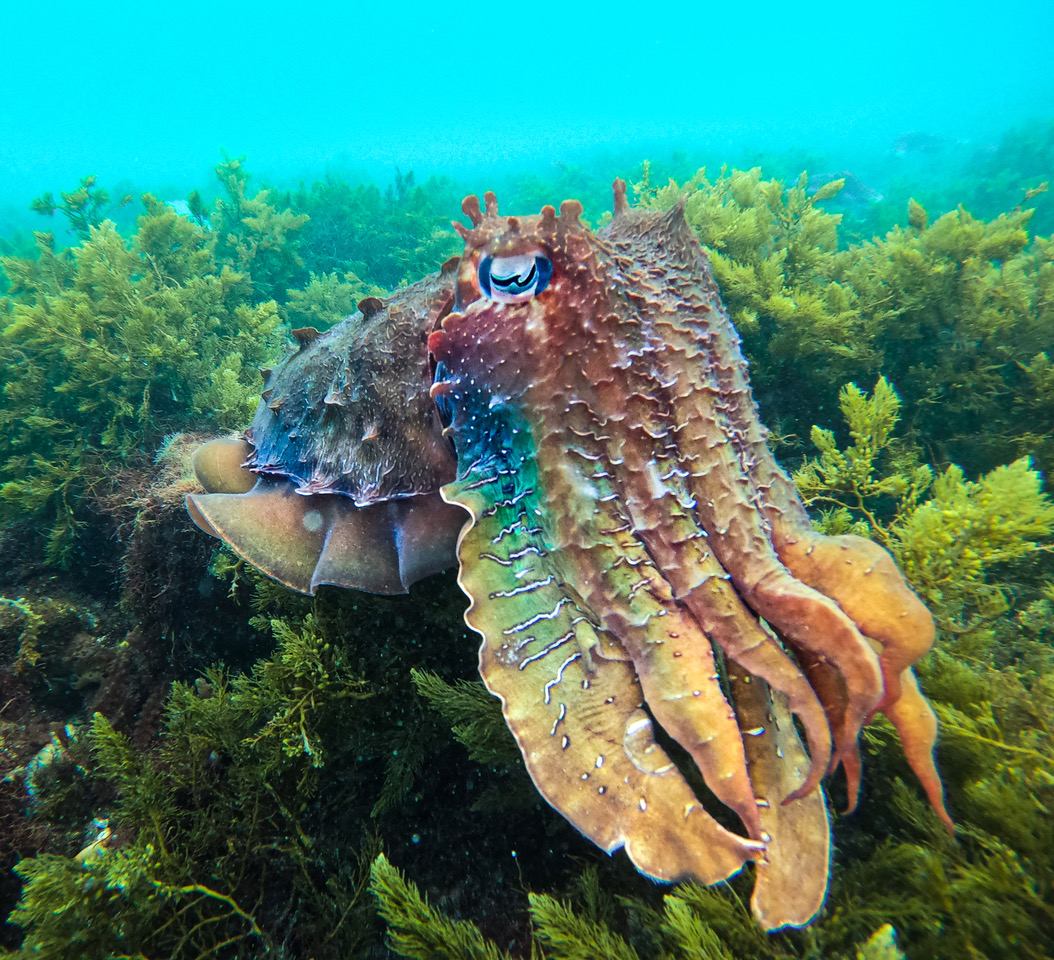Fears Gulf desal plant will devastate giant cuttlefish breeding grounds
Environmentalists are calling for Point Lowly to be dropped from a $15 million scoping plan for a desalination plant in the Upper Spencer Gulf, saying such a project could devastate one of the world’s largest Giant Australian Cuttlefish breeding sites.


Three sites including Point Lowly are being considered for a desalination plant in the Upper Spencer Gulf.
Conservation Council SA supporters also want Crag Point ruled out of three sites being considered for the Northern Water Supply project to provide desalinated sea water to mining, agriculture and renewable energy industries.
Hundreds of thousands of rare Giant Australian Cuttlefish (Sepia apama) gather along an 8km stretch of rocky reef at Point Lowly about 20km north east of Whyalla during the annual breeding season from May to August.
“It’s unique, it’s extraordinary, it’s a genuinely world significant natural event,” council chief executive Craig Wilkins said, warning that plant operations and salty discharge could affect the fragile ecosystem.
“Where else in the world can you take three steps off the water, put your head under and you are in the middle of a David Attenborough documentary?”
The latest consultation to build the plant comes 12 years after Transport and Infrastructure Minister Tom Koutsantonis approved a BHP Billiton plan to build a desalination plant at Point Lowly when he was part of the Weatherill Labor State Government.
It met resistance from environmentalists and fishers, and was eventually dropped when the company’s Olympic Dam mining site expansion did not go ahead.
Minister Koutsantonis is again the Minister overseeing the new desalination plant project, with the current business case assessment funded by the state and federal governments.
“Now 12 years on, if anything, the knowledge is even greater about how unique and wonderful this breeding ground is to the state,” Wilkins said, adding that there is a genuine alternative site to Point Lowly at Mullaquana.
“We have been very strongly and loudly saying this is a wonderful opportunity to avoid a 10-year pitched battle with the community by choosing a site that appears to have much better social, environmental and heritage values.”
Consultation is well underway to pick the preferred site for the plant and the conservation council is now calling on the wider community to add their voices to an online government survey closing at the end of February.
The business case to build a desalination plant is expected to be finished by the end of March.
Koutsantonis said the desalination plant proposed for the Olympic Dam expansion “was approved by a previous Labor government in entirely different circumstances”.
“The proposed Northern Water Supply (NWS) desalination plant is a new project that is being independently assessed by Infrastructure SA, and the government will consider its advice carefully,” he said.
Wilkins said siting the seawater desalination plant at Crag Point could also affect important prawn aggregations but said the Mullaquana site is most sustainable despite it likely being more expensive to build.
Giant Australian Cuttlefish that breed at Point Lowly are nicknamed the “rock stars of the ocean” because they live fast and die young, with a life span of just 12 to 18 months.

Giant Australian Cuttlefish are considered the rockstars of the ocean. Photo: Maeve Plouffe
Wilkins said this made the breeding season critical at the unique Port Lowly ecosystem, as the number of surviving eggs one year directly impacts the number of adult cuttlefish that return the next year to breed.
An Energy and Mining Department spokesperson confirmed the three sites under consideration were part of the business case to be delivered to the State Government during late March to early April.
The report will pinpoint one site for further analysis in building a plant and 450km pipeline, and its content means “potential costs will become clearer.”
“At this point the government will determine whether or not to proceed to the next phase,” the spokesperson said.
“Under this next phase, the study site will be subject to a range of detailed environmental studies – both marine and terrestrial – and consultations with community and industry, including local Aboriginal communities.”
The State Government is expected to make a final decision in mid-2024 about whether or not to support developing a desalination plant at any specific site under the NWS.
“Funding arrangements for the construction of a desalination plant under the NWS are yet to be finalised, and a range of options are being analysed,” the spokesperson said.
In October last year, 22 stakeholders met in Whyalla to discuss the project that would mean companies had less reliance on water from the Great Artesian Basin and River Murray.
Controversy has previously surrounded the giant cuttlefish when fishing of the species was allowed in 2020 outside the marine park restriction zone around Point Lowly for the first time since the grounds were protected in 2013.
Scientists are still pondering historical low numbers of cuttlefish at the breeding site during 2013, with Wilkins saying any changes to the ecosystem created by extra salinity discharge must be closely monitored.
“There were some scary years, cuttlefish live fast and die young,” he said, adding that studies were continuing at Adelaide University that suggest cuttlefish at the site are a unique population.
He said the gulf waters are also unique, and visitors around the world flock to Whyalla during breeding season to swim with the cuttlefish.
“The Upper Spencer Gulf is a marine reverse estuary, the water can take one to two years to circulate before fully being flushed out,” he said.
“This is a pivotal moment where the community can genuinely influence where this project is headed.”
Northern Water Supply project survey.




